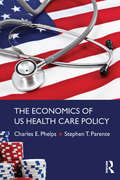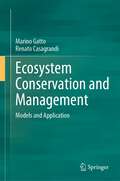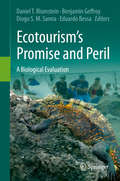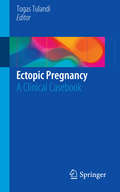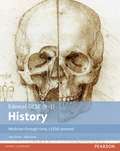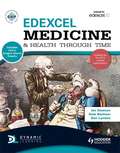- Table View
- List View
Economics of the Pharmaceutical and Medical Device Industry: Supply Chain, Trade and Innovation (Routledge Studies in the Economics of Innovation)
by Ramesh BhardwajThis book provides a comprehensive examination of the pharmaceutical and medical device industry, including analysis of its current trade and innovation strategies.Opening with a survey of the global pharmaceutical and medical device industry, Bhardwaj outlines the growing trade and trade interdependence among countries in the global supply chain. He adopts a trade competitiveness approach to analyze patterns of product specialization and examines the drug discovery process and its challenges in translating bioscientific knowledge into lifesaving products. Bhardwaj argues that further economic integration, collaborative R&D, and digital technologies may help accelerate productivity and address global challenges of escalating drug costs, neglected tropical diseases (NTDs), and pandemic risks. The book also considers how the industry may further green its supply chain, and thus contribute to SDG Goals 3 (Good Health and Wellbeing) and 12 (Responsible Consumption and Production), before closing on a review of China and India, major players who have the potential to become drivers of low-cost medical products and innovations.With its evidence-based analysis, this book will be of great interest to researchers in pharmaceutical studies, supply chain management, global health, and health economics, as well as policymakers and professionals interested in the global issues facing the industry.
The Economics of US Health Care Policy
by Charles E. Phelps Stephen T. ParenteIn this book, Phelps and Parente explore the US health care system and set out the case for its reform. They trace the foundations of today’s system, and show how distortions in the incentives facing participants in the health care market could be corrected in order to achieve lower costs, a higher quality of care, a higher level of patient safety, and a more efficient allocation of health care resources. Phelps and Parente propose novel yet economically robust changes to US tax law affecting health insurance coverage and related issues. They also discuss a series of specific improvements to Medicare and Medicaid, and assess potential innovations that affect all of health care, including chronic disease management, fraud and abuse detection, information technology, and other key issues. The Economics of US Health Care Policy will be illuminating reading for anyone with an interest in health policy, and will be a valuable supplementary text for courses in health economics and health policy, including for students without advanced training in economics.
The Economics of US Health Care Policy
by Charles E. Phelps Stephen T. ParenteIn this book, Phelps and Parente explore the US health care system and set out the case for its reform. They trace the foundations of today’s system, and show how distortions in the incentives facing participants in the health care market could be corrected in order to achieve lower costs, a higher quality of care, a higher level of patient safety, and a more efficient allocation of health care resources. Phelps and Parente propose novel yet economically robust changes to US tax law affecting health insurance coverage and related issues. They also discuss a series of specific improvements to Medicare and Medicaid, and assess potential innovations that affect all of health care, including chronic disease management, fraud and abuse detection, information technology, and other key issues. The Economics of US Health Care Policy will be illuminating reading for anyone with an interest in health policy, and will be a valuable supplementary text for courses in health economics and health policy, including for students without advanced training in economics.
ECOOP 2010 -- Object-Oriented Programming: 24th European Conference, Maribor, Slovenia, June 21-25, 2010, Proceedings (Lecture Notes in Computer Science #6183)
by Theo D'HondtEcosocial Theory, Embodied Truths, and the People's Health (Small Books Big Ideas in Population Health)
by Nancy KriegerFrom public health luminary Nancy Krieger comes a revolutionary way of addressing health justice and the embodied truths of lived experience. Since the 1700s, fierce debates in medicine and public health have centered around whether sources of ill health can be attributed to either the individual or the surrounding body politic. But what if instead health researchers measure--and policies address--how people biologically embody their societal and ecological context? Ecosocial Theory, Embodied Truths, and the People's Health represents a daring new foray into analyzing how population patterns of health reveal the intersections of lived experience and biology in historical context. Expanding on Nancy Krieger's original ecosocial theory of disease distribution, this volume lays new theoretical groundwork about embodiment and health justice through concrete and novel examples involving pathways such as workplace discrimination, relationship abuse, Jim Crow, police violence, pesticides, fracking, green space, and climate change. It offers a crucial counterargument to dominant biomedical and public health narratives attributing causality to either innate biology or decontextualized health behaviors and provides a key step forward towards understanding and addressing the structural drivers of health inequities and health justice. Bridging insights from politics, history, sociology, ecology, biology, and public health, Ecosocial Theory, Embodied Truths, and the People's Health presents a bold new framework to transform biomedical and population health thinking, practice, and policies and to advance health equity across a deeply threatened planet.
Ecosocial Theory, Embodied Truths, and the People's Health (Small Books Big Ideas in Population Health)
by Nancy KriegerFrom public health luminary Nancy Krieger comes a revolutionary way of addressing health justice and the embodied truths of lived experience. Since the 1700s, fierce debates in medicine and public health have centered around whether sources of ill health can be attributed to either the individual or the surrounding body politic. But what if instead health researchers measure--and policies address--how people biologically embody their societal and ecological context? Ecosocial Theory, Embodied Truths, and the People's Health represents a daring new foray into analyzing how population patterns of health reveal the intersections of lived experience and biology in historical context. Expanding on Nancy Krieger's original ecosocial theory of disease distribution, this volume lays new theoretical groundwork about embodiment and health justice through concrete and novel examples involving pathways such as workplace discrimination, relationship abuse, Jim Crow, police violence, pesticides, fracking, green space, and climate change. It offers a crucial counterargument to dominant biomedical and public health narratives attributing causality to either innate biology or decontextualized health behaviors and provides a key step forward towards understanding and addressing the structural drivers of health inequities and health justice. Bridging insights from politics, history, sociology, ecology, biology, and public health, Ecosocial Theory, Embodied Truths, and the People's Health presents a bold new framework to transform biomedical and population health thinking, practice, and policies and to advance health equity across a deeply threatened planet.
Ecosystem Change and Public Health: A Global Perspective
by Joan L. Aron Jonathan A. Patz"The purpose of this textbook on global ecosystem change and human health is twofold:(1) to raise awareness of changes in human health related to global ecosystem change and (2) to expand the scope of the traditional curriculum in environmental health to include the interactions of major environmental forces and public health on a global scale."—from the IntroductionEcosystem Change and Public Health focuses on how human health is affected by global ecosystem changes. It is the first textbook devoted to this emerging field, offering a global perspective on research methods and emphasizing empirical investigations of health outcomes in combination with integrated assessment for policy development. The book covers such topics as global climate change, stratospheric ozone depletion, water resources management, and ecology and infectious disease. Case studies of cholera, malaria, the effects of water resources, and global climate change and air pollution illustrate the analysis and methodology. The book also includes a resource center describing places to start searches on the World Wide Web, guidelines for finding and evaluating information, suggested study projects, and strategies for encouraging communication among course participants.
Ecosystem Conservation and Management: Models and Application
by Marino Gatto Renato CasagrandiThis textbook provides basic quantitative models allowing researchers and decision makers to a) assess viability of threatened populations and evaluate the success of species reintroductions, b) estimate invasion abilities of alien species, c) evaluate the persistence of metapopulations subjected to habitat destruction and fragmentation, d) analyze policies and strategies for the sustainable harvesting of biological resources, and e) assess the course of human and nonhuman diseases and the possible containment measures. Air and water pollution, overexploitation of renewable resources (e.g. marine fish stocks and forests), massive land-use change together with climate change impact the Earth biodiversity and impair the functioning of ecosystems. Globalization increases the risk of diffusion of alien species and new pathogens.A panoply of numerical problems mainly based on real data from the ecological literature enables the reader to practice the presented modelling tools.presented modelling tools. presented modelling tools. presented modelling tools. presented modelling tools. presented modelling tools. presented modelling tools. presented modelling tools. presented modelling tools.
Ecosystems and Human Health: A Critical Approach to Ecohealth Research and Practice
by Crescentia Y. DakuboEcosystems and Human Health introduces Ecohealth as an emerging field of study, traces its evolution, and explains its applications in cross-disciplinary and holistic programs. Its integrative approach not only focuses on managing the environment to improve health, but also analyzes underlying social and economic determinants of health to develop innovative, people-centered interventions.
Ecotourism’s Promise and Peril: A Biological Evaluation
by Daniel T. Blumstein Benjamin Geffroy Diogo S. Samia Eduardo BessaIntended as a guide for wildlife managers and ecotourism operators, as well as interested ecotourists, this book addresses the biological principles governing how ecotourism affects wildlife. The introductory chapters focus on four key responses to human visitation—behavioral, physiological, ecological, and evolutionary. Readers will discover ecotourism’s effects on biodiversity in connection with various industries that are habitat or taxonomically specific: fish tourism (including both freshwater and marine), marine mammal tourism, the huge industry centered on terrestrial animals, and the well-studied industry of penguin tourism. Given that the costs and benefits of ecotourism cannot be meaningfully assessed without understanding the human context, particular attention is given to how ecotourism has been used as part of community development. In closing, the book synthesizes the current state of knowledge regarding best practices for reducing human impacts on wildlife. The final chapter highlights key research questions that must be addressed to provide more evidence-based guidelines and policy.
Ecotoxicological Diagnosis in the Tanning Industry
by Mwinyikione MwinyihijaThe tanning industry is a major source of pollution worldwide, particularly in developing countries. The major public concern over tanneries has traditionally been about odours and water pollution from untreated discharges. Important poll- ants associated with the tanning industry include chlorides, tannins, chromium, sulphate and sulphides as well as trace organic chemicals and, increasingly, synthetic chemicals such as pesticides, dyes and finishing agents, as well as solvents. These substances are frequently toxic and persistent, and affect both human and environmental health. The primary focus in this book was to identify the recently developed ecoto- cological analytical trends (rapid, simple and inexpensive) related to the tanning industry on terrestrial and aquatic systems. The resultant research data reported, incorporates both field related and laboratory based techniques to address under- ing environmental problems in the tanning sector. The book also includes a chapter to explore the occupational hazards in a tannery environment caused by conta- nated dust. It was important to note that an optical set-up involving microscopy and digital imaging techniques was initially used to determine dust particle numbers and size distributions as a preamble to ascertaining the dust toxicity levels.
Ecotoxicological QSARs (Methods in Pharmacology and Toxicology)
by Kunal RoyThis volume focuses on computational modeling of the ecotoxicity of chemicals and presents applications of quantitative structure–activity relationship models (QSARs) in the predictive toxicology field in a regulatory context. The extensive book covers a variety of protocols for descriptor computation, data curation, feature selection, learning algorithms, validation of models, applicability domain assessment, confidence estimation for predictions, and much more, as well as case studies and literature reviews on a number of hot topics. Written for the Methods in Pharmacology and Toxicology series, chapters include the kind of practical advice that is essential for researchers everywhere. Authoritative and comprehensive, Ecotoxicological QSARs is an ideal source to update readers in the field with current practices and introduce to them new developments and should therefore be very useful for researchers in academia, industries, and regulatory bodies.
Ecotoxicology, Ecological Risk Assessment and Multiple Stressors (Nato Security through Science Series C:)
by Gerassimos Arapis Philippe Baveye Nadezhda GoncharovaThe science of ecotoxicology and the practice of ecological risk assessment are evolving rapidly. Ecotoxicology as a subject area came into prominence in the 1960s after the publication of Rachel Carson's book on the impact of pesticides on the environment. The rise of public and scientific concern for the effects of chemical pollutants on the environment in the 1960s and 1970s led to the development of the discipline of ecotoxicology, a science that takes into account the effects of chemicals in the context of ecology. Until the early 1980s, in spite of public concern and interest among scientists, the assessment of ecological risks associated with natural or synthetic pollutants was not considered a priority issue by most government. However, as the years passed, a better understanding of the importance of ecotoxicology emerged and with it, in some countries, the progressive formalization of an ecological risk assessment process. Ecological risk assessment is a conceptual tool for organizing and analyzing data and information to evaluate the likelihood that one or more stressors are causing or will cause adverse ecological effects. Ecological risk assessment allows risk managers to consider available scientific information when selecting a course of action, in addition to other factors that may affect their decision (e. g. , social, legal, political, or economic). Ecological risk assessment includes three phases (problem formulation, analysis, and risk characterization).
The Ecotoxicology of Aquatic Macrophytes (Environmental Contamination Remediation and Management)
by Mirta L. Menone Chris D. MetcalfeThis book focuses on the topic of ecotoxicology of aquatic macrophytes and is wide ranging, including the use of macrophytes for remediation of contaminated sites. Many human activities are threats to the equilibrium of natural ecosystems. Pollution from point and non-point sources can be assessed using a variety of techniques, such as biomonitoring, biomarkers and biosensors. In aquatic ecosystems, biomonitoring of pollutants is mostly conducted by analysis of the tissues of invertebrates and fishes, and biomarker studies are also more widely applied to animals rather than in plants. Aquatic macrophytes occupy a key niche in aquatic ecosystems and provide a range of ecosystem services. In addition to their role in primary production, vegetation plays a key role in the cycling and retention of nutrients and generally acts as a sink for pollutants. Therefore, because of their importance to aquatic ecosystems, more attention should be paid to understanding the fate of pollutants and to developing methods to evaluate the health status of macrophytic plants in freshwater, marine and estuarine environments.
Ecstasy: The Clinical, Pharmacological and Neurotoxicological Effects of the Drug MDMA (Topics in the Neurosciences #9)
by Stephen J. PeroutkaThe variety of viewpoints expressed in this book illustrate the many contro versies surrounding MDMA [1]. On the one hand, the proponents ofMDMA use believe this agent offers a unique psychoactive effect that may have important clinical applications, especially in the field of psychotherapy. On the other hand, the scientific data concerning the neurotoxic effects of the drug are unequivocal. The most striking feature of the human information of MDMA is the paucity of data that has been generated on the drug since it was patented in 1914. As pointed out by Beck (Chapter 6) and others, a clear need exists for better epidemiological and clinical data on MDMA. In the absence of such data, arguments both for and against the cotinued use ofMDMA with humans will be difficult to support. Unfortunately, the currently available data must be used to develop rational policies for potential human users of MDMA. At the present time, there are no data indicating that recreational doses of MDMA permanently damage the human brain. Nonetheless, based on a review of the contents of this book as well as on informal discussions with approximately 200 recreational users of MDMA, the following personal observations suggest that MDMA is radically different from other recreational drugs.
ECTO-NOX Proteins: Growth, Cancer, and Aging
by D. James Morré Dorothy M. MorréThis volume documents this unique family of cell surface proteins. Despite masquerading as intractable and difficult to clone and characterize, ENOX proteins have and continue to offer remarkable opportunities for research, commercial development and outside confirmation of therapeutic, diagnostic and new paradigms to help explain complex biological processes.
Ectoparasites: Drug Discovery Against Moving Targets (Drug Discovery in Infectious Diseases)
by Paul M. SelzerThis first book specifically dedicated to ectoparasite drug discovery is unique in providing insights from the veterinary as well as the medical perspective, covering research from both industry and academia while paving the way for new synergies between the two research communities. Edited by a team combining 80 years of experience in academic research and industrial antiparasitic drug discovery, this volume of Drug Discovery in Infectious Diseases summarizes current knowledge in this rapidly expanding field. Comprehensive yet concise, this ready reference blends solid background information on ectoparasite biology with the very latest methods in ectoparasite drug discovery. Three major parts cover current ectoparasite control strategies and the threat of drug resistance, screening and drug evaluation, and the new isoxazoline class of ectoparasiticides. The future potential of mechanism-based approaches for repellents and parasiticides is thoroughly discussed, as are strategies for vaccines against ectoparasites, making the book ideal for parasitologists in academia as well as researchers working in the pharmaceutical industry.
Ectoparasites: Drug Discovery Against Moving Targets (Drug Discovery in Infectious Diseases)
by Paul M. SelzerThis first book specifically dedicated to ectoparasite drug discovery is unique in providing insights from the veterinary as well as the medical perspective, covering research from both industry and academia while paving the way for new synergies between the two research communities. Edited by a team combining 80 years of experience in academic research and industrial antiparasitic drug discovery, this volume of Drug Discovery in Infectious Diseases summarizes current knowledge in this rapidly expanding field. Comprehensive yet concise, this ready reference blends solid background information on ectoparasite biology with the very latest methods in ectoparasite drug discovery. Three major parts cover current ectoparasite control strategies and the threat of drug resistance, screening and drug evaluation, and the new isoxazoline class of ectoparasiticides. The future potential of mechanism-based approaches for repellents and parasiticides is thoroughly discussed, as are strategies for vaccines against ectoparasites, making the book ideal for parasitologists in academia as well as researchers working in the pharmaceutical industry.
Ectopeptidases: CD13/Aminopeptidase N and CD26/Dipeptidylpeptidase IV in Medicine and Biology
by Jürgen Langner Siegfried AnsorgeThe idea to compile recent results on the ectoenzymes aminopeptidase N/CD13 and dipeptidylpeptidase IV/CD26 arose from the great interest given by readers world-wide to the two proceedings volumes edited by us in 1997 and 2000 (Ansorge and Langner, 1997; Langner and Ansorge, 2000). These volumes contained the presentations at two symposia held in Magdeburg (Germany) in 1996 and 1999 under the title "Cellular peptidases in immune functions and diseases", which was also the name of the Sonderforschungsbereich in Magdeburg, sponsored by the Deutsche Forschungsgemeinschaft between 1995 and 2001. Our groups in Magdeburg and Halle during the last two decades have provided results on these two enzymes in cells of the hematopoietic system that justify a review in an edited monograph like the present one (see the reviews by Kahne et at. , 1999; Lendeckel et at. ,1999; Riemann et at. , 1999). There are, however, many other groups in Europe, US and Japan which made important contributions to this field and particularly in topics improving the understanding of physiological and pathophysiological roles ofAPN/CD13 and DPIV/CD26. Therefore we decided to invite some of them to contribute reviews of their results to this book. Having worked for about 40 years in the field of proteolysis, for both of us to see the development of activities and knowledge from protein chemistry and enzymology to physiology and pathophysiology and even to therapy is very stimulating and fascinating. Of course, this development also reflects the dramatic improvement and refinement of methods.
Ectopic Pregnancy: A Clinical Casebook
by Togas TulandiComprised exclusively of clinical cases covering ectopic pregnancy, this concise, practical casebook will provide clinicians in reproductive medicine and obstetrics/gynecology with the best real-world strategies to properly diagnose and treat the various forms of the condition they may encounter. Each chapter is a case that opens with a unique clinical presentation, followed by a description of the diagnosis, assessment and management techniques used to treat it, as well as the case outcome and clinical pearls and pitfalls. Cases included illustrate different management strategies – from treatment with methotrexate to surgical interventions – as well as types of ectopic pregnancy, such as ovarian, interstitial, heterotopic and abdominal forms, among others. Pragmatic and reader-friendly, Ectopic Pregnancy: A Clinical Casebook will be an excellent resource for reproductive medicine specialists, obstetricians and gynecologists, and family and emergency medicine physicians alike.
Edelman and Kudzma's Canadian Health Promotion Throughout the Life Span - E-Book: Edelman and Kudzma's Canadian Health Promotion Throughout the Life Span - E-Book
by Shannon Dames Marian Luctkar-Flude Jane TyermanLearn the ins and outs of health promotion and disease prevention in Canada with Edelman and Kudzma’s Canadian Health Promotion Throughout the Life Span. This all-new, comprehensive text grounds you in the Canadian health objectives for promotion and prevention which aims to improve the health of the entire population and to reduce health inequities among population groups. Among the text’s chapters you’ll find extensive coverage of growth and development throughout the life span — including coverage of the normal aspects, the unique problems, and the health promotion needs that are found in each age and stage of development. Separate chapters discuss each population group — the individual, the family, and the community — and highlight the unique aspects of caring for each of these groups. In all, this comprehensive and culturally relevant text provides all the tools needed to stay up on the latest research and topics in Canadian health promotion.
Edexcel Gcse (9-1) History Medicine Through Time, C1250-present (PDF)
by Hilary Stark Sally ThorneExam Board: Edexcel Level: GCSE Subject: History First teaching: September 2016 First exams: Summer 2018 Series Editor: Angela Leonard This Student Book: covers the essential content in the new specification in an engaging way, using detailed narrative, sources, timelines, key words, helpful activities and extension material uses the 'Thinking Historically' approach and activities to help develop conceptual understanding of areas such as evidence, interpretations, causation and change, through targeted activities has 'Writing Historically' features that focus on the writing skills most important to historical success. This literacy support uses the proven Grammar for Writing approach used in many English departments includes lots of exam guidance, with practice questions, sources, sample answers and tips to support preparation for GCSE assessments. * These resources have not yet been endorsed. This information is correct as of 31st July 2015, but may be subject to change. You do not have to purchase any resources to deliver our qualification.
Edexcel GCSE History (9-1) (9-1) (9-1) (9-1): Medicine in Britain c1250-present with The British sector of the Western Front 1914-18 Student Book: And The British Sector Of The Western Front 1914-18
by James Ball Liam HallMedicine in Britain c1250-present with The British sector of the Western Front 1914-18 Student Book is part of Oxford's new Edexcel GCSE History series. This series provides the most up-to-date exam practice and a tried-and-trusted accessible approach to help students get the best grades they are capable of, and enjoy their history lessons.
Edexcel International Gcse (Edexcel International GCSE)
by Cathy WarrenEdexcel International GCSE (9-1) History prepares students for the new specification. These books provide comprehensive coverage of the latest Edexcel International GCSE (9-1) specification and are designed to supply students with the best preparation possible for the examination: written by a team of highly experienced History teachers, examiners, and authors each book provides free access to an ActiveBook, a digital version of the Student Book, which can be accessed online, anytime, anywhere supporting learning beyond the classroom chapters are mapped closely to the specification to provide comprehensive coverage learning is embedded with exercises, source materials and exam practice throughout transferable skills, needed for progression into higher education and employment, are signposted allowing students to understand, and engage with, the skills they're gaining Pearson progression tools allow quick and easy formative assessment of student progress, linked to guidance on how to personalise learning solutions. reviewed by a language specialist to ensure the book is written in a clear and accessible style for students whose first language may not be English glossary of key History terminology. Student Books will be available for the following units: Depth Studies Development of Dictatorship: Germany 1918-45 A World Divided: Superpower Relations, 1943-72 A Divided Union: Civil Rights in the USA, 1945-70 Dictatorship and Conflict in the USSR, 1924-53 Historical Investigations The USA, 1918-41 The Soviet Union in Revolution, 1905-24 The Origins and Course of the First World War, 1905-18 Breadth Studies Conflict, Crisis and Change: China, 1900-1989 Conflict, Crisis and Change: The Middle East, 1919-2012 The Changing Role of International Organisations: the League and the UN, 1919-2011 Changes in Medicine, c1848-c1948 Available: May to September 2017
Edexcel Medicine and Health Through Time (PDF)
by Ian Dawson Dan Lyndon Dale BanhamThis title is a course book for students taking the Edexcel Medicine Development Study. It covers all the relevant requirements of the Edexcel specification - both the Unit 1 Development Study and the Unit 3 Source Enquiry into the Transformation of Surgery.nbsp;

